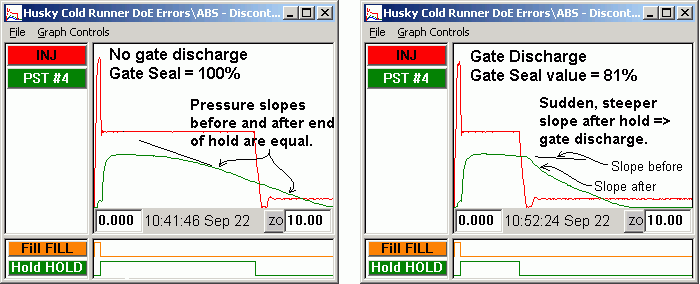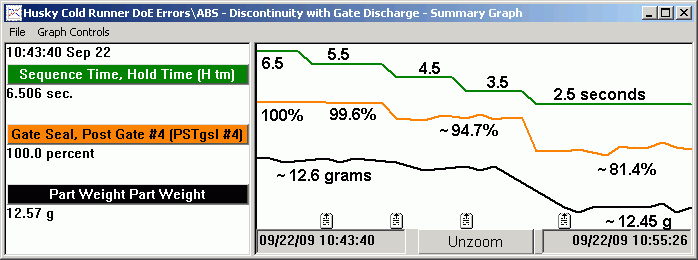Tip of the Day 157: Seeing Gate Discharge with Sensors
Recently a customer pointed out a common misconception in molding with cavity pressure control. His people were setting up D3 processes and getting very, very consistent peak pressures with sensors controlling cavity pressure. But the part dimensions still came out inconsistent or wrong. Why?
Gate discharge. Even though the peak pressures were consistent, the hold time was too short. The gate was not sealed or the parts were still molten inside. This let the plastic flow back out through the gate (discharge) when the hold pressure went to zero at the end of hold time.
The Plastic Variable “Pressure” is more than just peak.
If you want to hold consistent part dimensions in most parts (not yours, Ed) you should ensure that the material you put in stays in. We normally do this with a “Gate Seal Study”, weighing parts at different hold times. We then choose a hold time longer than the minimum required to keep the parts from loosing material (weight).
In the customer’s example above the parts are very, very small. They are so small that the resolution of the scales makes the gate seal study impractical. But, he has sensors near the gate in each cavity. So he can “see” whether material is discharging from the gate at the end of hold.

All he needs to do to ensure the material stays in is to add hold time until the curve no longer has the “kink” (discontinuity) in it. This usually works as well as a gate seal study by weight. Remember to add a little more time than the minimum to compensate for minor temperature or viscosity changes.
Note that this works even if you are not using cavity pressure control. With a D2 process and a PST sensor you can still see the same effect.
Gate Seal Value on eDART™
The eDART also computes a summary value for gate seal. You can add the value to Cycle Values, plot this value on the Summary Graph or set an alarm on it. Here is an example (from the Analyzer) showing how the gate seal value goes down as the hold time decreases.

The value of Gate Seal will be 100% when the slope of the pressure curve does not change at the end of hold. It will be 0% if the post gate pressure drops straight down at the end of hold.
Notes
- Mold deflection can prevent a good gate seal calculation. A rise in cavity pressure at the end of hold may make the gate seal calculation in-accurate or impossible for the eDART to compute at all.
- This tip looks like it applies to cold runner systems only. Not so. Hot runners may not exactly “seal” at the gate. But you can still see the discharge from the gate in the post gate curve. You can choose a hold time that is long enough to limit the gate discharge to a minimal amount that has little effect on the part dimensions. Do this with an experiment and then determine the minimum “Gate Seal” number that is acceptable for a good part.
- Even mid cavity sensors can sometimes see gate discharge. The thinner the part or the further from the gate the harder it is to see discharge. In all but the thickest parts the End of Cavity sensor will not see much gate discharge.

